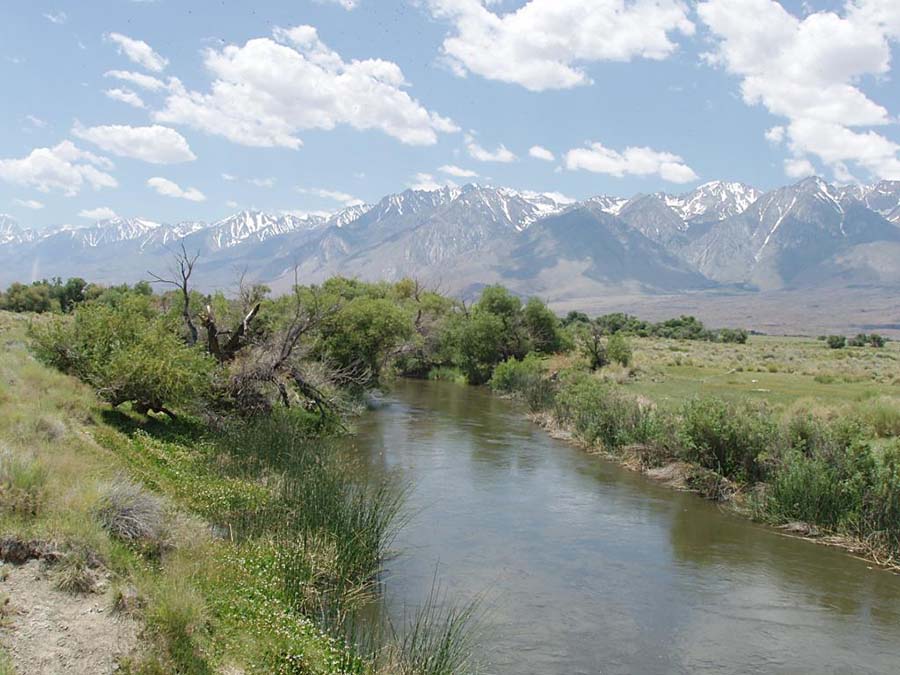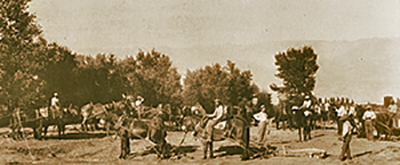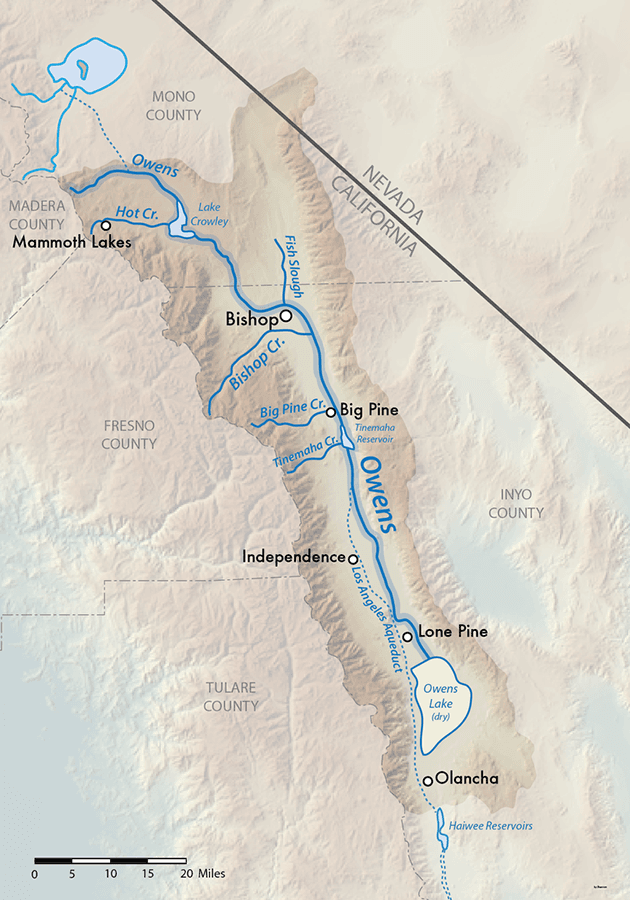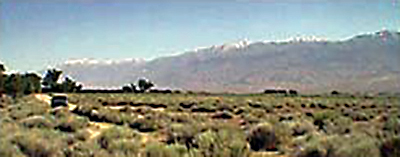Owens River Red Apple Railroad
The History
by David A. Wright

Owens River — South of Poverty Hills in the Owens Valley, the Eastern Sierra beyond. Photo by Richard E. Ellis, http://yosemitephotos.net/ - wikipedia
During the years around the turn of the century, Owens Valley citizens kept a close eye on local newspapers for the latest news after rumors suggested a plethora of new railroads would be coming to the region.

On June 18, 1911, 32 men and 60 mules and horses began turning soil, on the cut and fill near the Owens River.
The towns along the eastern foot of California's Sierra Nevada welcomed advancing railroads with open arms, but endured a love-hate relationship with them because those steel rails serving them for the last 80 years were located 3 to 5 miles east of their respective communities.
All of the "civilized" towns -- Bishop, Big Pine, Independence and Lone Pine -- were on Owens Valley's west side, nearer the foot of the Sierra, while the railroads favored the wild and desolate country on the east side of the relatively narrow valley, where the majority of mines were located.
So the Owens Valley towns created small villages surrounding "their" railroad stations: the Hamlet of Laws serviced Bishop; Zurich serviced Big Pine; Citrus ministered to Independence; Mount Whitney Station supported Lone Pine. But all were at least an hour away by wagon or by foot or a hot and dusty trip in early autos, which were prone to break down or suffer a flat tire or two on the way.

Map of the Owens Lake/River watershed in eastern California, USA. Shaded relief from US Geological Survey data. Includes LA Aqueduct and Mono Basin Extension, shown by dotted lines.
Shannon1, CC BY-SA 4.0
Finally, in November, 1910, Harry Shaw and H.N. Beard incorporated the Owens River Valley Electric Railway Company. Their route was projected to run between Main Street in Bishop, California, 4 miles to the sizable railroad community of Laws on the Southern Pacific line. Originally, the new line was to utilize gasoline motor cars, but later it was decided to use narrow gauge electrical trolleys with electrical power supplied by overhead wires. There was also talk of creating branch lines to access the agricultural farmlands of Round Valley, 12 miles northwest and south 15 miles to the town of Big Pine. Initial surveys were begun in February 1911.
Early in 1911, advertisements in the Inyo Register began promoting the railway and a combined land promotion scheme involving a 1,300-acre apple-growing region just south of Bishop. Railroad stock was soon offered, with free matching shares in the Aqueduct Lands and Orchards Co. Before long, a brochure entitled "The Big Red Apple -- The Money Tree" was circulated, prompting locals to dub the planned railroad project the "Red Apple." By the end of March 1911, surveys were completed.
In June, it was announced that all rights of way had been acquired and that the route would largely follow level ground, with some fills and one cut near the Owens River. Two bridged crossings -- one over the Owens River and another over Bishop Creek were required. Plans called for operations to begin as a narrow gauge with provisions to easily convert to standard gauge, if and when Southern Pacific did so on the Owens Valley branch. In June, the construction contract was awarded to Herbert Francisco and Niel McLean, who projected a 90-day completion schedule.. The groundbreaking ceremony occurred June 16, 1911.
On June 18, 1911, 32 men and 60 horses began turning soil, on the cut and fill near the Owens River crossing, just west of Laws. Four carloads of pipe arrived on the Southern Pacific for the 39 planned culverts. Property was acquired in nearby Black Canyon in the White Mountains for a sawmill to create fencing material. The primary source of wood was Bristlecone Pine, now recognized as one of earth's oldest living organisms.
By the end of August, grading was complete along with the sawmill at Black Canyon. Rumors began circulating that operation would begin using gasoline motor cars, then convert to electricity as rolling stock began to arrive from the manufacturer. In November, work was suspended for the winter with exception of right-of-way fencing.
By this time, skeptics were silenced by the physical presence of a completed grade, and over the winter their anticipation rose with dreams of being able to travel in comfort from their own homes. But when spring arrived, no activity resumed on the freshly turned earth running to Laws. There was no word from corporation officials, and the local newspaper remained silent.
Finally in June 1912, the president of the corporation issued a public declaration stating that "large plans are maturing, looking to work on the road in the near future." Thereafter, anticipation remained high, but, nothing ever again occurred, in either in word or action, except that the line appeared on the 1913 USGS topographic map as a completed railroad.
Why the venture failed remains a mystery, although some theorize that large-scale and highly aggressive land acquisitions by the City of Los Angeles for the purpose of water rights to feed its aqueduct were somehow responsible.

Looking along the grade at the SW corner of Bishop.
The grade of the "Red Apple" is still visible today and is easily traced for much of the distance between Bishop and Laws. In fact fishermen looking for that great fishing spot on the Owens River don't even realize they are driving on a piece of history. The grade is so well preserved. that during the late 1960s, the Laws Railroad Museum, composed of artifacts from narrow gauge days, considered clearing brush off the grade, placing rails on it, to operate a tourist line between Bishop and Laws, utilizing the old Brill motor car once operated by the Death Valley Railroad or restoring SP locomotive #9.5 But cost estimates for construction and operation (in 1969) of $1 million per mile quickly scuttled this idea.
The Owens River Valley Electric Railroad was indeed a "short line," in that it was physically stunted and died aborning. But today it affords a few hours of pleasure to the history buff like myself. Come and see for yourself.
For the explorer, most of the old Apple Railroad grade is usually navigable by any vehicle. The north end of the line near Laws can be accessed by U.S. Highway 6, and the south end is accessed from Bishop. Read this article for information on how to explore the line: Exploring the Red Apple Railroad Line
Share this page on Facebook:
The Desert Environment
The North American Deserts
Desert Geological Terms



